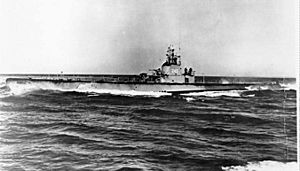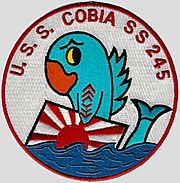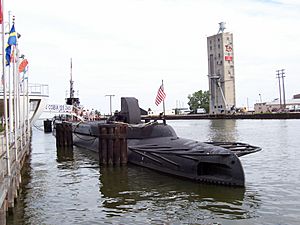USS Cobia facts for kids

USS Cobia (SS-245)
|
|
Quick facts for kids History |
|
|---|---|
| Namesake | Cobia |
| Ordered | 9 September 1940 |
| Builder | Electric Boat Company, Groton, Connecticut |
| Laid down | 17 March 1943 |
| Launched | 28 November 1943 |
| Sponsored by | Mrs. C. W. Magruder |
| Commissioned | 29 March 1944 |
| Decommissioned | 22 May 1946 |
| Recommissioned | 6 July 1951 |
| Decommissioned | 19 March 1954 |
| Stricken | 1 July 1970 |
| Status | Memorial at Manitowoc, Wisconsin, 17 August 1970 |
| Badge |  |
| General characteristics | |
| Class and type | Gato-class diesel-electric submarine |
| Displacement |
|
| Length | 311 ft 9 in (95.02 m) |
| Beam | 27 ft 3 in (8.31 m) |
| Draft | 17 ft (5.2 m) maximum |
| Propulsion |
|
| Speed |
|
| Range | 11,000 nmi (20,000 km) surfaced at 10 kn (19 km/h) |
| Endurance |
|
| Test depth | 300 ft (90 m) |
| Complement | 10 officers, 70 enlisted |
| Armament |
|
|
USS Cobia (submarine)
|
|
| Location | Manitowoc, Wisconsin |
| Built | 1943 |
| Architect | Electric Boat Co. |
| NRHP reference No. | 86000087 |
| Significant dates | |
| Added to NRHP | 14 January 1986 |
| Designated NHL | 14 January 1986 |
The USS Cobia (SS/AGSS-245) is a famous Gato-class submarine. It was part of the United States Navy and is named after the cobia, a type of fish.
This submarine is special because it was named a National Historic Landmark. This honor was given for its important service during World War II. The Cobia fought in the Pacific Ocean and earned four battle stars for its bravery. Today, you can visit the Cobia as a museum ship at the Wisconsin Maritime Museum in Manitowoc, Wisconsin.
Contents
Building a Submarine: The Cobia's Start
The Cobia began its life on March 17, 1943. It was built by the Electric Boat Company in Groton, Connecticut. This is when the first part of its structure, called the keel, was put down.
The submarine was launched into the water on November 28, 1943. Mrs. C. W. Magruder was its sponsor, a special role in ship launches. Finally, on March 29, 1944, the Cobia was commissioned. This meant it was officially ready for service in the Navy, with Lieutenant Commander Albert L. Becker as its first captain.
Cobia's Adventures: World War II Patrols
The Cobia arrived at Pearl Harbor on June 3, 1944. Soon after, it began its important missions during World War II.
First Patrol: Action in the Pacific
On June 26, 1944, the Cobia started its first war patrol. It headed towards the Bonin Islands in the Pacific. In July, it successfully sank three Japanese freighters. One of these, the Nisshu Maru, was a troop transport carrying tanks for Japanese soldiers. All 28 tanks went to the bottom of the sea.
Later, on July 20, the Cobia had a gun battle and sank three small armed ships. One enemy ship even rammed the Cobia, but the submarine only had minor damage. On August 5, it sank another ship and rescued a survivor, who became the Cobia's first prisoner of war.
Second and Third Patrols: Rescues and Discoveries
After getting supplies at Majuro, the Cobia went on its second patrol in the Luzon Strait. During this time, Japanese aircraft often attacked it. On October 22, the submarine rescued two survivors from a Japanese ship that another American submarine had sunk.
The Cobia then went to Fremantle for repairs. Its third patrol began on November 30, heading into the South China Sea. On January 14, 1945, it sank the Japanese minelayer Yurishima. The next day, it rescued two Japanese sailors who had been lost at sea for 40 days.
Fourth Patrol: A Brave Crew's Sacrifice
After more repairs, the Cobia began its fourth patrol in the Java Sea. On February 26, it attacked two "sea trucks." One of these trucks fought back with machine gun fire. This damaged the Cobia's radar and sadly killed Ralph Clark Huston Jr., a 20-year-old gun loader. He was the only Cobia crew member lost during the war.
After sinking both sea trucks, the Cobia returned for quick repairs. It then went back to the Java Sea. On April 8, it rescued seven crew members from a U.S. Army bomber that had crashed.
Fifth and Sixth Patrols: Final Missions
The Cobia resupplied at Subic Bay and then started its fifth patrol in the Gulf of Siam. On May 14, it attacked a cargo ship but was forced to dive deep by enemy depth charges. Its luck changed on June 8, when it found a tanker convoy. The Cobia successfully sank both a tanker and a landing craft called Hakusa.
After its final repairs, the Cobia began its sixth and last war patrol. On July 27, it dropped off intelligence teams along the coast of Java. It then acted as a lifeguard for air strikes near Formosa until the war ended. The submarine returned to Saipan on August 22, 1945.
The Cobia's first, third, fourth, and fifth patrols were very successful. For its service, it received four battle stars. It is credited with sinking a total of 16,835 tons of enemy ships.
From Warship to Museum: Cobia's Later Life
After the war, the Cobia sailed to Pearl Harbor and then to New York and New London. It was taken out of service on May 22, 1946, and kept in reserve.
The Cobia was brought back into service on July 6, 1951. It was used to train Navy reservists and students at the Submarine School in New London. It was taken out of service again on March 19, 1954.
By 1959, the Navy decided the Cobia was too old for active combat. It was sent to the Milwaukee, Wisconsin Naval Reserve Center. For the next eleven years, it served as a training platform. On December 1, 1962, it was renamed an Auxiliary Submarine, AGSS-245.
On July 1, 1970, the Navy officially removed the Cobia from its list of ships. It was then towed to Manitowoc, Wisconsin. There, it became a special memorial for all submariners around the world. In 1986, the Cobia became part of the Wisconsin Maritime Museum. It was also declared a National Historic Landmark and added to the National Register of Historic Places.
Today, the Cobia is permanently docked at the mouth of the Manitowoc River on Lake Michigan. Visitors can take tours of the submarine every day. Groups or individuals can even stay overnight on the ship!
Thanks to ongoing restoration and care, the Cobia is in amazing condition. Many of its original systems still work. This includes two of its main diesel engines, the radio room, and the SJ-1 radar. This radar is thought to be the oldest working radar system in the world!





